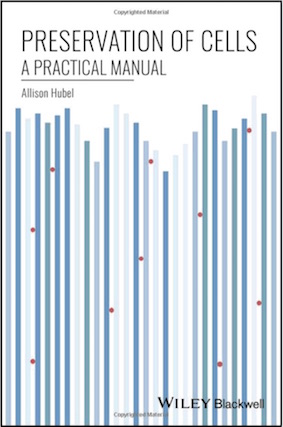 A new book has just been published by Professor Allison Hubel of the University of Minnesota. It aims to provide readers interested in cryo bio banking with the tools needed to develop or debug a preservation protocol for cells. The core structure and content of the text grew from a professional short course that she has offered at the Biopreservation Core Resource over the last 10 years. The text describes, step by step, the individual elements of a protocol, including the relevant scientific principles for each phase. It can be used by anyone who is involved in cell preservation - including those not expert in the freezing of cells; it does provide the scientific basis for those that want to understand the basis for the protocol.
A new book has just been published by Professor Allison Hubel of the University of Minnesota. It aims to provide readers interested in cryo bio banking with the tools needed to develop or debug a preservation protocol for cells. The core structure and content of the text grew from a professional short course that she has offered at the Biopreservation Core Resource over the last 10 years. The text describes, step by step, the individual elements of a protocol, including the relevant scientific principles for each phase. It can be used by anyone who is involved in cell preservation - including those not expert in the freezing of cells; it does provide the scientific basis for those that want to understand the basis for the protocol.
The book covers pre-freeze Processing and Characterization; Formulation and Introduction of Cryopreservation Solutions; Freezing Protocols; Storage and Shipping of Frozen Cells; Thawing and Post Thaw Processing; Post-thaw Assessment; and Algorithm driven Protocol Optimisation. Professor Hubel explains the reasons behind every step in the development of a preservation protocol and the scientific principles behind them and provides alternative modes of preservation for when conventional methods of cryopreservation are not appropriate for a given cell type or application.
 Mammalian cells have become modern workhorses capable of a variety of applications, such as in production of therapeutic proteins, viral vaccines, antibodies and therapeutic agents. Cells that are to be used therapeutically must be properly stored to meet the safety and quality control testing prior to release of the cells. There are a variety of methods that can be used to preserve cells depending upon downstream application. Specific practices are intended to improve both the outcome and the reproducibility of preservation protocols. The preservation toolkit is used to develop fit-for-purpose preservation protocols. Each element of a protocol is based on scientific principles and those principles are explained and can be used to rationally design that particular step to achieve the desired downstream use of the cell. The influence of processing procedures on the health of cells prior to cryopreservation and strategies to mitigate stress on cells is explained along with the formulation and introduction of cryopreservation solutions.
Mammalian cells have become modern workhorses capable of a variety of applications, such as in production of therapeutic proteins, viral vaccines, antibodies and therapeutic agents. Cells that are to be used therapeutically must be properly stored to meet the safety and quality control testing prior to release of the cells. There are a variety of methods that can be used to preserve cells depending upon downstream application. Specific practices are intended to improve both the outcome and the reproducibility of preservation protocols. The preservation toolkit is used to develop fit-for-purpose preservation protocols. Each element of a protocol is based on scientific principles and those principles are explained and can be used to rationally design that particular step to achieve the desired downstream use of the cell. The influence of processing procedures on the health of cells prior to cryopreservation and strategies to mitigate stress on cells is explained along with the formulation and introduction of cryopreservation solutions.
There is a specific chapter on controlled rate freezing with all the steps of a controlled rate freezing protocol and guiding principles for design of that step are given. Also described is a process for transferring units from a controlled rate freezer to a storage unit and there are examples showing good and bad freezing curves. Prof Hubel also covers storage and shipping of frozen cells, processing, assessment, protocol optimisation and the cryopreservation of endothelial cells in suspension, peripheral blood mono nuclear cells from whole blood, human adipose stem cells, red blood cells, oocytes and more.
Preservation of Cells: A Practical Manual is an important book for researchers, laboratory technicians and students in cell biology, stem cell biology, tissue engineering, and regenerative medicine. It is also useful to cell bankers, regenerative medicine, biomarker discovery or precision medicine companies, and cell therapy labs, blood bankers, biobankers, and biotechnology companies.
For further information:
Prof Allison Hubel http://www.me.umn.edu/people/hubel.shtml
Preservation of Cells: A Practical Manual (John Wiley & Sons, Inc., Print ISBN: 9781118989845)
https://www.wiley.com/en-gb/Preservation+of+Cells:+A+Practical+Manual-p-9781118989845
